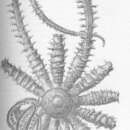Comprehensive Description
(
англиски
)
добавил Smithsonian Contributions to Zoology
Brisingella coronata (G.O. Sars, 1871)
Brisinga coronata G.O. Sars, 1871:5.—Thomson, 1873:66 (part).—G.O. Sars, 1875:1–112, pls. 1–6.—Ludwig, 1878:216–234, pl. 15.—Perrier, 1882:61.—Danielssen and Koren, 1884:104.—Carus, 1885:91.—Perrier, 1885d:442–444; 1885b:4–5.—Sladen, 1889:598, 601–604, 832.—Bell, 1889:433.—Sladen, 1891:698.—Bell, 1892[1893]:105.—Norman, 1893:347.—von Marenzeller, 1893a:66–70; 1893b:65–67.—Perrier, 1894:50, 51, 54, 68–70, pl. 1: figs 1, 2, 4–6.—von Marenzeller, 1895a:189–191.—Koehler, 1896a:440; 1896b:38–40.—Perrier, 1896:20.—Ludwig, 1897a:308; 1897b:418–438; 1900:488.
Brisinga sp.—Marion, 1883:129–136.
Brisinga mediterranea Perrier, 1885d:442, 444; 1885b:3–4.—Sladen, 1889:602, 603, 834.—Perrier, 1894:51, 70–71, pl. 1: fig. 3, pl. 3: fig. 1.—von Marenzeller, 1895b:137.—Boone, 1933:93.
Brisingella coronata.—Mortensen, 1927:127.—Grieg, 1927b: 127; 1928:1.—John and A.M. Clark, 1954:151.—Gage et al, 1983:285.
MERISTICS.—Arms = 9–12, R = 310 mm (estimated), r = 7–15 mm, R/r = 20.7/1, length of gonadal region = 75 mm, length of longest arm spine = 20 mm.
DIAGNOSIS.—[80.a] Madreporite large; [100.a] madreporite channeled; [110.c] abactinal disc plates small, tubercular; [120.a,d] abactinal disc plates few, in irregular radiating rows, not dense; [130.b] abactinal disc plates bearing 1 moderately long, mobile, denticulate spine; [170] number of arms 9–12; [205.a,c] gonadal region of arms 75 mm long, slightly to highly inflated; [210.a] abactinal arm plates rod-like; [240.b] costal plates each bearing a long, glassy spine; [250.a] terminal plates small relative to marginals; [260.b] terminal plates shield-shaped; [270.a] terminal plates armed with 8 or 9 outwardly directed webbed spines, central 3 longest; [280.a] marginal plates small; [290.a] marginals irregular; [300.b] marginals occurring about every other adambulacral; [310.b] marginals bearing 1 spinelet; [320.a] adambulacrals higher than long; [330.d] adambulacral plates hourglass-shaped; [340.b] furrow margin slightly indented; [350] number of furrow spines 2–4; [360.a] furrow spines tiny, acicular; [370.c] furrow spines medial; [380] number of subambulacral spines 1 or 2; [390.a] subambulacral spines moderately long, acicular; [420.a] ambulacral plates moderately high; [430.c] ambulacrals broadly Y-shaped; [470.b] tubefeet rather heavy; [480.a] mouth plates rather small relative to adambulacrals; [490.e] mouth plates short, broad; [500] number of preoral spines per mouth plate 2; [510.a] preoral spines acute; [520.a] preoral spines adoral; [530] number of lateral oral spines per mouth plate 1; [540.a] lateral oral spines acute; [550.b] lateral oral spines lateral; [560] number of suboral spines per mouth plate 1; [570.a] suboral spines acute; [580.c] suboral spines in center of mouth plate; [620.a,b,c] pedicellariae on both surfaces of disc and arms, in bands or rows on arms; [630.a] all pedicellariae microscopic.
COLOR.—Orange to red.
TYPE.—Bergens Museum; Lofoten, Norway, 549 m.
MATERIAL EXAMINED.—1 specimen, BM(NH), from off Ireland; 1 specimen, USNM 18288, HMS Pola, off Samothraki, Turkey, 40°17′N, 25°13′E, 588 m.
DISTRIBUTION.—Norway to Azores and Cape Verde Islands; Mediterranean; 100–2600 m.
- библиографски навод
- Downey, Maureen E. 1986. "Revision of the Atlantic Brisingida (Echinodermata:Asteroidea), with description of a new genus and family." Smithsonian Contributions to Zoology. 1-57. https://doi.org/10.5479/si.00810282.435

